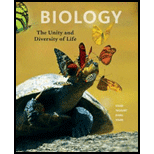
Concept explainers
_______ is the arrival of pollen on a receptive stigma.
Concept introduction:
A flower is the reproductive part of the modified thick shoot of an angiosperm plant. The transfer of pollen from a male part to the female part of a plant allows the fertilization to occur and later develops into a seed. Pollination takes place with the help of pollinating agents such as wind or animal.
Answer to Problem 1SQ
Correct answer: Pollination is the arrival of pollen on a receptive stigma.
Explanation of Solution
In the flowering plants, pollination is one of the necessary processes for sexual reproduction. Pollination involves the arrival of pollen grains on a receptive stigma. The flowers containing both carpels and stamens are called perfect flowers and they can pollinate themselves. On the other hand, the flowers which don’t possess the carpels and stamens are called imperfect flowers and do not pollinate themselves.
Want to see more full solutions like this?
Chapter 29 Solutions
Biology: The Unity and Diversity of Life (MindTap Course List)
- 22. Which of the following mutant proteins is expected to have a dominant negative effect when over- expressed in normal cells? a. mutant PI3-kinase that lacks the SH2 domain but retains the kinase function b. mutant Grb2 protein that cannot bind to RTK c. mutant RTK that lacks the extracellular domain d. mutant PDK that has the PH domain but lost the kinase function e. all of the abovearrow_forwardWhat is the label ?arrow_forwardCan you described the image? Can you explain the question as well their answer and how to get to an answer to an problem like this?arrow_forward
- Describe the principle of homeostasis.arrow_forwardExplain how the hormones of the glands listed below travel around the body to target organs and tissues : Pituitary gland Hypothalamus Thyroid Parathyroid Adrenal Pineal Pancreas(islets of langerhans) Gonads (testes and ovaries) Placentaarrow_forwardWhat are the functions of the hormones produced in the glands listed below: Pituitary gland Hypothalamus Thyroid Parathyroid Adrenal Pineal Pancreas(islets of langerhans) Gonads (testes and ovaries) Placentaarrow_forward
 Biology: The Unity and Diversity of Life (MindTap...BiologyISBN:9781305073951Author:Cecie Starr, Ralph Taggart, Christine Evers, Lisa StarrPublisher:Cengage Learning
Biology: The Unity and Diversity of Life (MindTap...BiologyISBN:9781305073951Author:Cecie Starr, Ralph Taggart, Christine Evers, Lisa StarrPublisher:Cengage Learning Biology 2eBiologyISBN:9781947172517Author:Matthew Douglas, Jung Choi, Mary Ann ClarkPublisher:OpenStax
Biology 2eBiologyISBN:9781947172517Author:Matthew Douglas, Jung Choi, Mary Ann ClarkPublisher:OpenStax
 Concepts of BiologyBiologyISBN:9781938168116Author:Samantha Fowler, Rebecca Roush, James WisePublisher:OpenStax College
Concepts of BiologyBiologyISBN:9781938168116Author:Samantha Fowler, Rebecca Roush, James WisePublisher:OpenStax College





